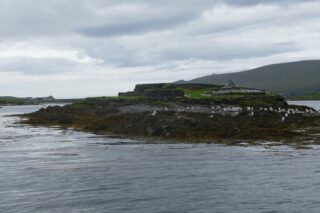Notice
Illaunloughan Monastery is a National Monument in state guardianship
*Public Access is Not Permitted on Illaunloughan Island*
WARNING: It should be noted that these sites are unguided and a level of care and caution should be maintained during all stages of your visit. The Office Of Public Works (OPW) will not be held responsible for any damages, injuries, or losses that occur
Illaunloughan Monastery
Slightly north of Portmagee village in the Portmagee channel is a low lying island, 0.3 acres, called Illaunloghan/Oileán Lócháin. This tiny island is the site of an early medieval ecclesiastical complex. It is thought the name of this island came from the local saint Lóchán. The settlement dates to the 7th century and was in use as a ceallúnach/cillín, a historical burial site for stillborn and unbaptised infants, and those who were not allowed in consecrated ground, up to the 20th During excavations these burials are noted to have simple uninscribed headstones with the skeletons of the infants well preserved. These later burials were laid to rest on the western side of the island. Several excavations have been done on this island, and many publications have resulted from them.
The church/oratory is located on the eastern side of the island and is built using a dry-stone technique. The construction used horizontally laid slabs with rounded edges. A doorway on its west side gives internal access. Several upright slabs are visible. Excavations show that the oratory sat on top of a leacht (a small drystone platform thought to function as a burial place, altar or shrine) to the north. Radio carbon dating of the clay of the stone floor places it around 640-790 AD.
At the north-eastern edge of the island the gable-shrine and leacht are found. The gable-shrine consists of two slate slabs leaning against each other with its interior scattered with stone and quartz. Excavation revealed the gable-shrine held two small cists containing exhumed human bone (said to date back to the 7th and 8th centuries), scallop shells and quartz pebbles.
The leacht held a number of graves, which are thought to be for the monks of the island. At least five bodies were interred, laying side by side. All graves were found to have scallop shells scattered around, which was the emblem of St. James. A further three graves were found that predated the construction of the gable-shrine leading to speculation of an even earlier shrine. This sort of gable-shrine has been suggested to mark the grave of the founder.
A hut is fund on the south-west of the island and is a dry stone corbelled structure. Excavations reveal the interior floor was below the external ground level. A middden deposit, waste material, is found south-east of the hut and consisted largely of shells, bone, an antler comb, bone beads and two bronze ring-broches and charcoal. The charcoal was dated to the 11th century. Excavations have shown that this hut was constructed over a previous hut as animal bone was carbon dated to 777-961 AD.
Monastic period burials were concentrated around the oratory and gable-shrine. In the medieval period the burials were to the north, south and west of the oratory. All of the graves were aligned east to west, with many having quartz pebbles placed on the body or neatly around the slab base. Radio carbon dating showed this part of the graveyard was from the early medieval period. Excavations also showed the grave in use in the later medieval period, as six silver pennies of Edward I and III were placed with a burial.
Protect our Past - Click here to read about the importance of protecting our country’s unique heritage sites
This national monument is protected in accordance with the National Monuments Acts 1930 to 2014
Gallery
Nearby sites to visit
Sceilg Mhichíl UNESCO World Heritage Property
An island monastery towering over the sea
Approx. 16.1 km from Illaunloughan Monastery
Daniel O’Connell House – Derrynane House
The childhood home of Daniel O’Connell
Approx. 21.7 km from Illaunloughan Monastery
Ionad an Bhlascaoid – The Blasket Centre
The story of a remarkable island community
Approx. 28.0 km from Illaunloughan Monastery
Ilnacullin – Garinish Island
An island garden of rare beauty
Approx. 59.5 km from Illaunloughan Monastery
Ross Castle
A lakeside citadel steeped in legend
Approx. 60.2 km from Illaunloughan Monastery
Ardfert Cathedral
A trio of medieval churches devoted to St Brendan
Approx. 63.6 km from Illaunloughan Monastery




